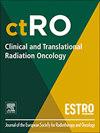Fully automatic reconstruction of prostate high-dose-rate brachytherapy interstitial needles using two-phase deep learning-based segmentation and object tracking algorithms
IF 2.7
3区 医学
Q3 ONCOLOGY
引用次数: 0
Abstract
The critical aspect of successful brachytherapy (BT) is accurate detection of applicator/needle trajectories, which is an ongoing challenge. This study proposes a two-phase deep learning-based method to automate localization of high-dose-rate (HDR) prostate BT catheters through the patient’s CT images. The whole process is divided into two phases using two different deep neural networks. First, BT needles segmentation was accomplished through a pix2pix Generative Adversarial Neural network (pix2pix GAN). Second, a Generic Object Tracking Using Regression Networks (GOTURN) was used to predict the needle trajectories. These models were trained and tested on a clinical prostate BT dataset. Among the total 25 patients, 5 patients that consist of 592 slices was dedicated to testing sets, and the rest were used as train/validation set. The total number of needles in these slices of CT images was 8764, of which the employed pix2pix network was able to segment 98.72 % (8652 of total). Dice Similarity Coefficient (DSC) and IoU (Intersection over Union) between the network output and the ground truth were 0.95 and 0.90, respectively. Moreover, the F1-score, recall, and precision results were 0.95, 0.93, and 0.97, respectively. Regarding the location of the shafts, the proposed model has an error of 0.41 mm. The current study proposed a novel methodology to automatically localize and reconstruct the prostate HDR-BT interstitial needles through the 3D CT images. The presented method can be utilized as a computer-aided module in clinical applications to automatically detect and delineate the multi-catheters, potentially enhancing the treatment quality.

基于两阶段深度学习分割和目标跟踪算法的前列腺高剂量率近距离治疗间质针全自动重建。
成功近距离放射治疗(BT)的关键在于准确检测涂药器/针头轨迹,这是一项持续的挑战。本研究提出了一种基于深度学习的两阶段方法,通过患者的 CT 图像自动定位高剂量率(HDR)前列腺近距离放射治疗导管。整个过程分为两个阶段,使用两种不同的深度神经网络。首先,通过 pix2pix 生成对抗神经网络(pix2pix GAN)完成 BT 针头分割。其次,使用回归网络(GOTURN)进行通用对象跟踪,以预测针的轨迹。这些模型在临床前列腺 BT 数据集上进行了训练和测试。在总共 25 名患者中,5 名患者的 592 个切片被用作测试集,其余的用作训练/验证集。这些 CT 图像切片中的针头总数为 8764 个,其中使用的 pix2pix 网络能够分割其中的 98.72 %(总数的 8652 个)。网络输出与地面实况之间的骰子相似系数(DSC)和交集大于联合(IoU)分别为 0.95 和 0.90。此外,F1 分数、召回率和精确度结果分别为 0.95、0.93 和 0.97。关于轴的位置,建议模型的误差为 0.41 毫米。本研究提出了一种通过三维 CT 图像自动定位和重建前列腺 HDR-BT 间质针的新方法。该方法可作为临床应用中的计算机辅助模块,自动检测和划分多导管,从而提高治疗质量。
本文章由计算机程序翻译,如有差异,请以英文原文为准。
求助全文
约1分钟内获得全文
求助全文
来源期刊

Clinical and Translational Radiation Oncology
Medicine-Radiology, Nuclear Medicine and Imaging
CiteScore
5.30
自引率
3.20%
发文量
114
审稿时长
40 days
 求助内容:
求助内容: 应助结果提醒方式:
应助结果提醒方式:


